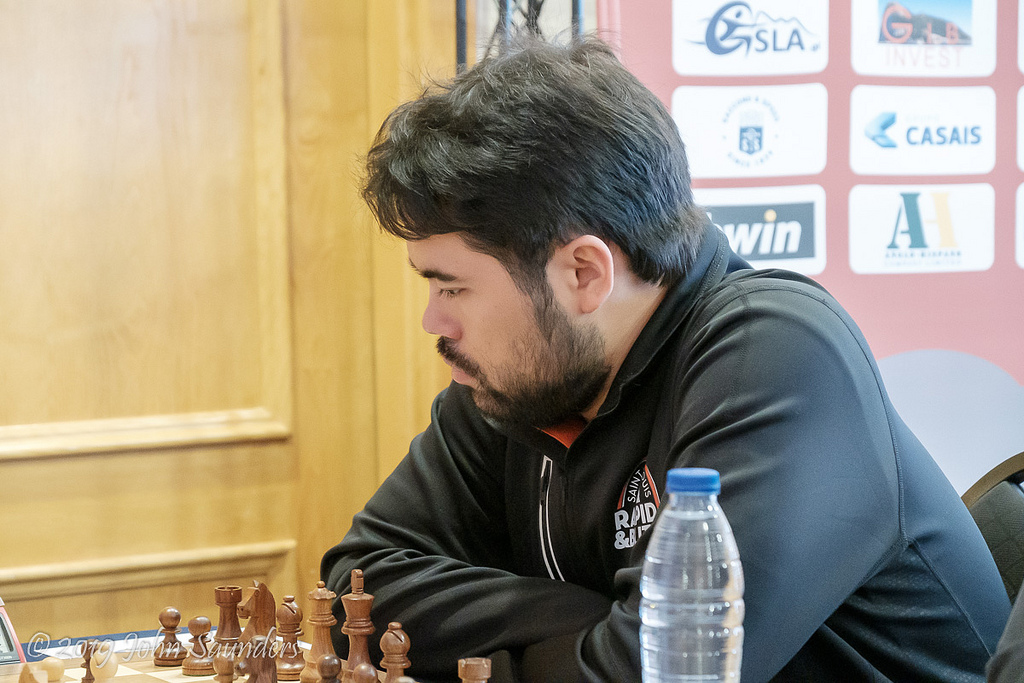


The first round of big open Swiss tournaments typically sees large rating differentials on all boards as the first half of the starting list plays against those in the second half. The games themselves are not necessarily one-sided, but the results mostly match up to Elo expectations.
In 2018, Levon Aronian drew in the first round and then went on to win the tournament. This year it was former Gib-champ Hikaru Nakamura who struggled with black against 2390-rated Vaso Blesic's London system, barely squeezing any advantage from the solid white structure.

Nakamura sporting a St. Louis Rapid and Blitz jacket | Photo: John Saunders
Nakamura had to settle for a draw in the rook ending:
As a result, Nakamura was paired way down on board 52 for the second round (a board that was not broadcast live) and there he drew again! So the American has a bit of a hole to dig himself out of.
Yu Yangyi also could not gain an advantage against Ariel Erenburg and the latter even missed a golden opportunity:
Erenburg played 25...Qe5 here and the game later ended up in a balanced rook ending. Instead, 25...Qb6 -+ would have left White with too many weaknesses to survive.
The roller coaster ride of the day was provided by Hrant Melkumyan and Dina Belenkaya. In the exchange variation of the Caro-Kann Defence, the Russian WGM she won an exchange for a pawn. The position was objectively balanced but maybe a bit easier for Melkumyan to play with the knight. Belenkaya defended well and had a moment to leverage the power of her rook with a difficult-to-spot clearance sacrifice:
After 60...Kb7 the game began to tip in the Armenian's favour. The chance to strike was 60...Re2! followed by d4 to open up lines on the long diagonal for the queen.

Dina Belenkaya | Photo: David Llada
Nevertheless, Belenkaya retained drawing chances until White spotted an easy conversion to a winning pawn ending:
Melkumyan calculated 109.Qg3+ out to a win as the g-pawn cannot be stopped.
This marathon of a game stood in stark contrast to the miniature between FM Peter Lombaers and GM Gawain Jones. The affable Englishman took control early on the black side of a symmetrical English opening, then dealt several massive blows in the ensuing middlegame.
18...Bb5+ 19.Kg1 Bd3 20.Qb2 Qh5! and the one-sided battle did not last long.

Gawain Jones | Photo: David Llada
Wesley So, playing the white side of a Sveshnikov Sicilian in Round 2, mirrored his teammate Fabiano Caruana from Game 8 of the World Championship match. So's opponent, Polish GM Daniel Sadzikowski deviated from Magnus Carlsen (and others) on move 13 and So got a nice advantage in the resulting middlegame by giving up his queen for rook and bishop:
Retreating the queen and allowing the exchange of light-square bishops would be equal but, of course, So had planned 18.Qxf5! Rxf5 19.Bxf5 and now 19...Nf6 20.Be3 Qb8 21.c4 leaves white with a pleasant edge. Sadzikowski's 19...a6 let So grab an even bigger advantage with 20.Nxd6 Qxd6 21.Bxg4 Qxd5 22.Bc3. From there on it only increased.

So looks surprised by the opening choice of David Navara | Photo: John Saunders
Navara was content to play a Pirc Defence, weathering some opening pressure to emerge with an equal and dynamic middlegame — so far so good for a strategy with Black against a lower-rated player, GM Thai Dai Van Nguyen. Navara won a pawn, but White was keeping himself in the game until this moment:
34.Qa7 was a bit careless, overlooking that after 34...d4! The d-pawn simply cannot be stopped.
Le Quang Liem and Vladislav Artemiev are two other 2700-players among the 33 in total who remain perfect with 2/2.
There's a lot of chess still to be played in Gibraltar, however!
Correction Jan 24 — The colours in the game Yu vs Erenburg were incorrectly stated. Yu was white and Erenberg was black.
Andre Schulz contributed reporting